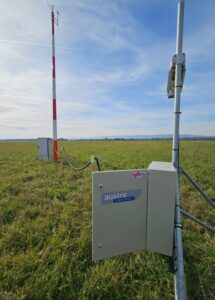Improving Safety in the Open Air

Lightning discharge near Graz Airport.
(c) RTLRA 2024 - TU Graz
TU Graz Evaluates Lightning Risk in Real Time.
Airport aprons, large construction sites or open-air events are usually defenceless against lightning. To increase safety and reduce downtimes, electrical engineers at TU Graz are developing a forecasting system.
Thunderstorms and working outdoors are bad companions. As it is not possible to predict when and where the next lightning discharge will strike, all activities in working areas with high exposure to lightning, such as on the apron of an airport, are suspended for safety reasons. In effect shut down. These forced breaks in operation can last from a few minutes to several hours and result in high consequential costs. A team from the Institute of High Voltage Engineering and System Performance at Graz University of Technology (TU Graz) wants to reduce such downtimes. In the RTLRA (Real Time Lightning Risk Assessment) project, researchers are developing a system to evaluate the local risk of lightning reaching the Earth’s surface in real time. The aim is to improve the safety of people and infrastructure, optimise the efficiency of operations during thunderstorms and support meteorologists in risk assessment. The Austrian Research Promotion Agency (FFG) has funded the project.
Electric field meters at Graz Airport

(c) RTLRA 2024 – TU Graz
At the core of the RTLRA project was the installation of a network of six electrical field meters (FM) within a radius of ten kilometres around Graz Airport, which is a very suitable location for measurements due to the high frequency of thunderstorms and lightning density. Field meters measure the electrostatic field strengths in their immediate vicinity, something which changes due to the accumulation of charges in thunderclouds. The researchers combine the data from these field strength measurements in real time with data from the Austrian lightning location system ALDIS (Austrian Lightning Detection and Information System) run by OVE GmbH and weather radar data from Austro Control GmbH.
By analysing and combining the collected data points, the research team was able to develop parameters for predicting lightning from thunderstorm cells approaching the airport. The results showed that the system is able to successfully predict the time of the first lightning discharge in the airport area in over 75% of cases. A forecast is considered successful if it orders a shutdown two to 30 minutes before the first lightning discharge reaches the ground. The knowledge gained is collated in an automated evaluation algorithm in order to obtain short-term forecasts for thunderstorms and lightning for airport operations and thus to be able to issue more precise warnings and all-clear signals.
Machine learning: Detection of lightning discharges in weather radar data
In addition to the traditional methods of thunderstorm forecasting, machine learning was also used. An artificial neural network was trained using weather radar images and lightning location system data to enable pre-classification of weather radar data in relation to lightning activity. This system was able to determine with an accuracy rate of over 85 % whether lightning discharges would occur in the study area during the period under consideration. The methods and technologies developed in the project could also be used in the future in other areas with high exposure to thunderstorms, such as outdoor events, large construction sites or critical infrastructure.
“In the RTLRA project, we have succeeded in making it possible to predict the first lightning discharges,” says Stephan Pack from the Institute of High Voltage Engineering and System Performance, who implemented the project together with Lukas Schwalt, Sebastian Schatz and Julia Maier. “The fact that we were able to successfully predict the first lightning discharge in around 75% of the thunderstorms analysed is an important step towards greater safety when working outdoors. We are convinced that with further research and more data, some improvements are still possible and that weather-related downtimes can be significantly reduced in the future. We expect the final results with the completion of Sebastian Schatz’s doctoral thesis.”
Wissenschaftliche Ansprechpartner:
Stephan PACK
Ao.Univ.-Prof.i.R. Dipl.-Ing. Dr.techn.
TU Graz | Institute of High Voltage Engineering and System Performance
Phone: +43 316 873 7416
pack@tugraz.at
Sebastian SCHATZ
Dipl.-Ing. BSc
TU Graz | Institute of High Voltage Engineering and System Performance
Phone: +43 316 873 7406
sebastian.schatz@tugraz.at
Media Contact
All latest news from the category: Power and Electrical Engineering
This topic covers issues related to energy generation, conversion, transportation and consumption and how the industry is addressing the challenge of energy efficiency in general.
innovations-report provides in-depth and informative reports and articles on subjects ranging from wind energy, fuel cell technology, solar energy, geothermal energy, petroleum, gas, nuclear engineering, alternative energy and energy efficiency to fusion, hydrogen and superconductor technologies.
Newest articles

Tackling Life-Threatening Fungal Infections Using RNA Modifications
Importance of RNA modifications for the development of resistance in fungi raises hope for more effective treatment of fungal infections. An often-overlooked mechanism of gene regulation may be involved in…

Unraveling Aphasia: Global Study Breaks Down Patients’ Struggle with Verb Tenses
An international team of researchers, including scientists from the HSE Centre for Language and Brain, has identified the causes of impairments in expressing grammatical tense in people with aphasia. They discovered…

Facing the Storm: A Prepped Up Future Against Extreme Climatic and Weather Changes
From the persistent droughts of southern Africa and Central America in the early part of the year to the more recent devastating extreme rainfall in Spain and the deadly Hurricane…



